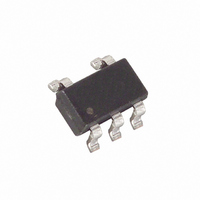DS1819AR-10+T&R Maxim Integrated Products, DS1819AR-10+T&R Datasheet - Page 2

DS1819AR-10+T&R
Manufacturer Part Number
DS1819AR-10+T&R
Description
IC MICROMON 3V W/PBRST SOT-23-5
Manufacturer
Maxim Integrated Products
Series
MicroMonitor™r
Type
Simple Reset/Power-On Resetr
Datasheet
1.DS1814CR-10TR.pdf
(8 pages)
Specifications of DS1819AR-10+T&R
Number Of Voltages Monitored
1
Output
Push-Pull, Totem Pole
Reset
Active Low
Reset Timeout
140 ms Minimum
Voltage - Threshold
2.925V
Operating Temperature
-40°C ~ 85°C
Mounting Type
Surface Mount
Package / Case
SOT-23-5, SC-74A, SOT-25
Monitored Voltage
1 V to 5.5 V
Undervoltage Threshold
2.85 V
Overvoltage Threshold
3 V
Manual Reset
Resettable
Watchdog
Yes
Battery Backup Switching
No
Power-up Reset Delay (typ)
280 ms
Supply Voltage (max)
5.5 V
Supply Voltage (min)
1 V
Supply Current (typ)
12 uA
Mounting Style
SMD/SMT
Maximum Operating Temperature
+ 85 C
Chip Enable Signals
No
Minimum Operating Temperature
- 40 C
Output Type
Active Low or Push-Pull
Power Fail Detection
Yes
Lead Free Status / RoHS Status
Lead free / RoHS Compliant
Other names
DS1819AR-10+T&R
DS1819AR-10+T&RTR
DS1819AR-10+T&RTR
The DS1814/DS1819 ‘A’ and ‘C’ perform pushbutton reset control. They debounce the pushbutton input
and generate an active reset pulse width of 140ms minimum. The DS1814/9 ‘A’ and ‘B’ versions perform
a watchdog function. The watchdog is an internal timer that forces the reset signals to the active state if
the strobe input does not change state every 1.12 seconds. The watchdog timer function can be disabled
by leaving the watchdog strobe input disconnected.
OPERATION
Power Monitor
The DS1814 detects out-of-tolerance power supply conditions and warns a processor-based system of
impending power failure. When V
RST).
last possible moment of valid V
to allow the power supply and processor to stabilize.
Pushbutton Reset
The DS1814 ‘A’ and ‘C’ provide an input pin for direct connection to a pushbutton reset (see Figure 2).
The pushbutton reset input requires an active low signal. Internally, this input is debounced and timed
such that a
commences as the pushbutton reset input is released from the low level (see Figure 3).
Watchdog Timer
The DS1814/DS1819 ‘A’ and ‘B’ versions watchdog timer function forces
active when the
the watchdog starts when
prior to time-out, the watchdog timer is reset and begins to time out again. If the watchdog timer is
allowed to time out, then the reset output(s) will go active for 140ms. The watchdog can be disabled by
floating (or tri-stating) the
The
microprocessor data I/O signals and control signals. When the microprocessor functions normally, these
signals would as a matter of routine cause the watchdog to be reset prior to time-out. To guarantee that
the watchdog timer does not time out, a transition must occur at or less than 1.12 seconds. A typical
circuit example is shown in Figure 4. The DS1814/19 watchdog function can be disabled at any time by
tri-starting the strobe input. A sample circuit to disable the watchdog is shown in Figure 6.
ST
RST
input can be derived from many microprocessor outputs. The most typical signals used are the
(or RST) are excellent control signals for a microprocessor, as processing is stopped at the
RST
ST
(or RST) signal of at least 140ms minimum will be generated. The 140ms delay
input is not clocked within the 1.12 second watchdog time-out period. Time-out of
RST
ST
input.
CC
(and RST) become(s) inactive. If a transition occurs on the
. On power-up,
CC
falls below a preset level, a comparator outputs the signal
RST
2 of 8
(or RST) are kept active for a minimum of 140ms
RST
(and RST) signal(s)
DS1814/DS1819
ST
input pin
RST
(or










